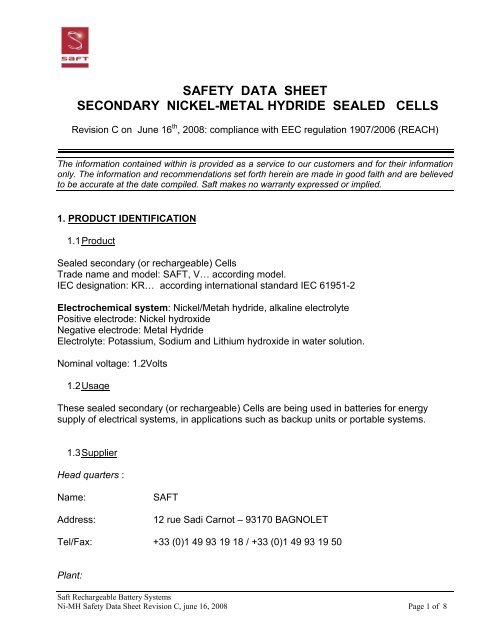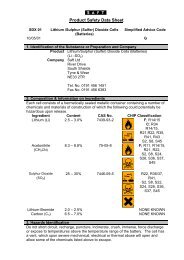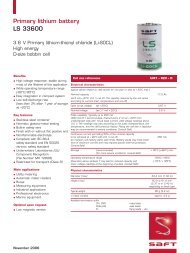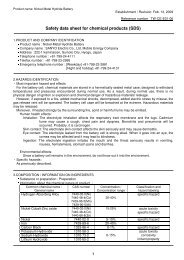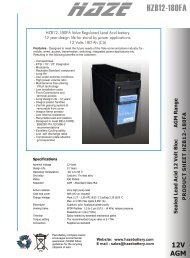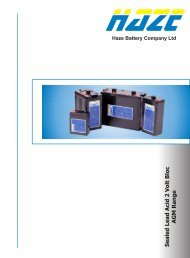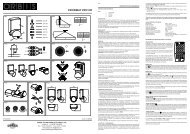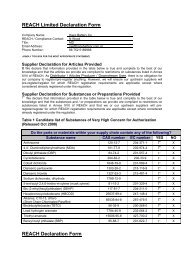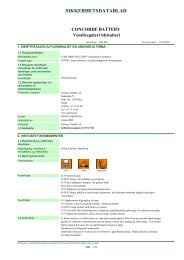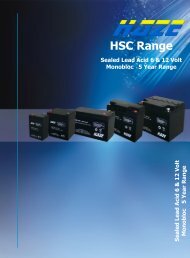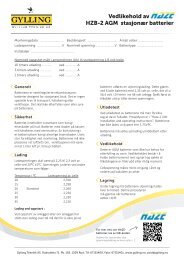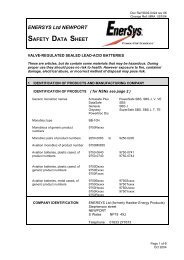SAFT NiMH MSDS - MK Battery
SAFT NiMH MSDS - MK Battery
SAFT NiMH MSDS - MK Battery
You also want an ePaper? Increase the reach of your titles
YUMPU automatically turns print PDFs into web optimized ePapers that Google loves.
SAFETY DATA SHEET<br />
SECONDARY NICKEL-METAL HYDRIDE SEALED CELLS<br />
Revision C on June 16 th , 2008: compliance with EEC regulation 1907/2006 (REACH)<br />
The information contained within is provided as a service to our customers and for their information<br />
only. The information and recommendations set forth herein are made in good faith and are believed<br />
to be accurate at the date compiled. Saft makes no warranty expressed or implied.<br />
1. PRODUCT IDENTIFICATION<br />
1.1 Product<br />
Sealed secondary (or rechargeable) Cells<br />
Trade name and model: <strong>SAFT</strong>, V… according model.<br />
IEC designation: KR… according international standard IEC 61951-2<br />
Electrochemical system: Nickel/Metah hydride, alkaline electrolyte<br />
Positive electrode: Nickel hydroxide<br />
Negative electrode: Metal Hydride<br />
Electrolyte: Potassium, Sodium and Lithium hydroxide in water solution.<br />
Nominal voltage: 1.2Volts<br />
1.2 Usage<br />
These sealed secondary (or rechargeable) Cells are being used in batteries for energy<br />
supply of electrical systems, in applications such as backup units or portable systems.<br />
1.3 Supplier<br />
Head quarters :<br />
Name:<br />
Address:<br />
<strong>SAFT</strong><br />
12 rue Sadi Carnot – 93170 BAGNOLET<br />
Tel/Fax: +33 (0)1 49 93 19 18 / +33 (0)1 49 93 19 50<br />
Plant:<br />
Saft Rechargeable <strong>Battery</strong> Systems<br />
Ni-MH Safety Data Sheet Revision C, june 16, 2008 Page 1 of 8
Name:<br />
Address:<br />
<strong>SAFT</strong>- Nersac<br />
Zone Industrielle – 16440 NERSAC - FRANCE<br />
Tel/Fax: +33 (0)5 45 90 50 26 / +33 (0)5 45 90 57 06<br />
1.4 Contact in case of emergency<br />
Emergency contact: Tel +33 (0)1 49 93 19 18<br />
Internet: www.saftbatteries.com section “contact”<br />
2. HAZARDS IDENTIFICATION<br />
A- Human hazards<br />
A sealed Nickel-Metal Hydryde cell is not hazardous in normal use.<br />
2.1 Physical<br />
Nickel plated steel cans do not present any risk if cells are used for its intended purpose<br />
and according to valid directions for use.<br />
Do not throw in fire or misuse, as a gas containing hydrogen and oxygen can be<br />
generated through the safety valve ( explosion risk).<br />
3.2 Chemical<br />
Nickel plated steel cans do not present chemical risk in normal use.<br />
In case of misuse (abusive over charge, reverse charge, external short circuit…) and in<br />
case of default, some electrolyte can leak from the cell through the safety vent.<br />
In these cases refer to the risk of the Alcaline hydroxides.<br />
The toxic properties of the electrode materials are hazardous only if the materials are<br />
released by mechanical damaging the cell or if exposed to fire.<br />
B- Environnemental hazards<br />
Metals used in a Ni-MH cell have to be collected and recycled through specialised<br />
organisations ( list on WWW.rechargebatteries.org).<br />
Saft Rechargeable <strong>Battery</strong> Systems<br />
Ni-MH Safety Data Sheet Revision C, june 16, 2008 Page 2 of 8
3. COMPOSITION<br />
Weight percentage of basic materials:<br />
Single cell with steel container<br />
Metals % Plastics % Other %<br />
Iron Fe 15 – 30 Polyamide PA /PP 2.5 - 3.5 Alcalis K/Na/Li 1.8 – 3.2<br />
Nickel Ni 30 – 45 EPDM < 0.05 Water H2O 4 - 9<br />
Rare Earth, Mn, Al 7 - 15 Polyethylene PE 0.2 - 0.4 Hydroxyle OH- 8 – 14<br />
Cobalt Co 1 - 5 PVC 0.2 - 0.7<br />
Classification of dangerous substances contained into the cells.<br />
SUBSTANCES<br />
CLASSIFICATION<br />
Name N° EC<br />
N° CAS<br />
N° EINEC<br />
Symbol Letter Identification<br />
of danger<br />
Nickel 028-002-00-7<br />
7440-02-0<br />
231-111-4<br />
Nickel<br />
Hydroxyde<br />
Cobalt<br />
Hydroxyde<br />
Potassium<br />
Hydroxyde<br />
Sodium<br />
Hydroxyde<br />
Lithium<br />
Hydroxyde<br />
028-008-x*<br />
12054-48-7<br />
235-008-5<br />
-<br />
21041-93-0<br />
244-166-4<br />
019-002-00-8<br />
1310-58-3<br />
215-181-3<br />
011-002-00-6<br />
1310-73-2<br />
215-185-5<br />
-<br />
1310-65-2<br />
215-183-4<br />
(1) Nature of special risk<br />
Special risk<br />
(1)<br />
Ni Xn Nocif R 40-43<br />
R 17<br />
Ni(OH)2 Xn; N Carc. cat 3<br />
Harmful<br />
R 20/22, 43,<br />
40<br />
R 50/53<br />
Safety<br />
advice<br />
(2)<br />
S2, 22, 36<br />
S2<br />
S 22 ,36,<br />
60, 61<br />
Co(OH)2 Xn; N Harmful R22-43-50/53 S2-24-37;<br />
60,61<br />
KOH C, Xi Corrosive ,<br />
Irritant<br />
R 35, 22<br />
R36-37<br />
S 26-37/39<br />
-45<br />
NaOH C Corrosive R35 S 26-37/39<br />
-45<br />
LiOH C Corrosive R 35 S 26-37/39<br />
-45<br />
R 17: Spontaneously flammable in air<br />
R 20/21/22 : Harmful by inhalation, skin contact or if swallowed.<br />
R 20/22: Harmful by inhalation or ingestion.<br />
R 22: Harmful by ingestion.<br />
R 35: Causes serious burns.<br />
R 36/37: Sensitising for eyes and respiratory system.<br />
R 40: Carcinogenic effect suspected. Possible risk of irreversible effects.<br />
R 43: May cause sensitising by skin contact.<br />
R42/43: May cause sensitising by inhalation and skin contact.<br />
Saft Rechargeable <strong>Battery</strong> Systems<br />
Ni-MH Safety Data Sheet Revision C, june 16, 2008 Page 3 of 8
R50/53: Very toxic for aquatics organisms, possible harmful long term effect on<br />
aqueous environnement.<br />
(2) Safety advice<br />
S 2: keep out of reach of children.<br />
S 7/8: keep the container close<br />
S 22: Do not breathe dust.<br />
S 24: Avoid contact with skin<br />
S 26: In case of contact with eyes, rinse immediately with plenty of water and<br />
seek medical advice.<br />
S 36: Wear suitable protection clothing.<br />
S 37: Wear suitable gloves.<br />
S 37/39: Wear suitable gloves and eyes/face protection.<br />
S 45: In case of accident or if you feel unwell, seek medical advice immediately.<br />
S 60: Eliminate as a dangerous product.<br />
S 61: Avoid disposal in the environment. Consult the information about<br />
recycling.<br />
4. FIRST AID MEASURES<br />
In case of electrolyte solution spill ( cell leakage) precautions must be taken to avoid any<br />
contact of human tissues. If it accidentally happens following must be done:<br />
4.1 Inhalation<br />
Fresh air. Rinse mouth and nose with water. Medical treatment.<br />
4.2 Skin contact<br />
Rinse immediately with plenty of water. Medical treatment.<br />
4.3 Eyes contact<br />
Rinse immediately with plenty of water during at least 15-30 min .Immediate hospital<br />
treatment. Consult eye specialist.<br />
4.4 Ingestion<br />
If the injured is fully conscious: plenty of drink, preferably milk. Do not induce vomiting.<br />
Immediate Hospital treatment.<br />
5. FIRE FIGHTING MEASURES<br />
5.1 Extinguishing media<br />
Suitable: Class D-Dry chemical, sand, CO2.<br />
Not to be used : Water.<br />
Saft Rechargeable <strong>Battery</strong> Systems<br />
Ni-MH Safety Data Sheet Revision C, june 16, 2008 Page 4 of 8
5.2 Special exposure hazards<br />
Cells can be overheated by an external source or by internal shorting and release<br />
alcaline electrolyte mist or liquid. Electrolyte reacts with zinc, aluminum, tin and other<br />
active materials releasing flammable hydrogen gas.<br />
In case of PVC sleeved products, the combustion releases chloride gas.<br />
5.3 Special protective equipment<br />
Use self-contained breathing apparatus and full fire-fighting protective clothing.<br />
6. SPILL MANAGEMENT PROCEDURE<br />
The sealed Ni-MH cells when sleeved are safe in case of spilling.<br />
Non-sleeved cells may generate short-circuits, causing release of alkaline electrolyte mist<br />
or liquid. Electrolyte reacts with zinc, aluminium, tin and other active materials releasing<br />
flammable hydrogen gas.<br />
6.1 Individual protections and equipments:<br />
In such a case, use self-contained breathing apparatus and protective clothing.<br />
6.2: Environnemental precautions:<br />
No urgency measure requested.<br />
6.3: cleaning<br />
Collect the cells for recycling, if necessary use sawdust to absorb electrolyte leakages.<br />
7. HANDLING USAGE AND STORAGE PRECAUTIONS<br />
In normal use conditions, no safety rule is specified to handle the cells. Please apply<br />
<strong>SAFT</strong> usage instructions.<br />
It is recommended to store following <strong>SAFT</strong> specifications in order to ensure longer<br />
usage: +5 to +25°C in a 65 +- 5% relative humidity.<br />
8. EXPOSURE CONTROLS/PERSONAL PROTECTION<br />
Under normal condition of use and handling no special protection is required for sealed<br />
Ni-MH cells.<br />
Protection equipments: it is recommended to wear gloves, or to remove rings and<br />
metallic objects to avoid short-circuiting the cells.<br />
Saft Rechargeable <strong>Battery</strong> Systems<br />
Ni-MH Safety Data Sheet Revision C, june 16, 2008 Page 5 of 8
9. PHYSICAL PROPERTIES<br />
9.1 Appearance<br />
Nickel plated steel cylindrical cell, eventually sleeved. Dimensions and colour according<br />
specification.<br />
9.2 Temperature range<br />
Usage recommendd between -40°C and +70°C.<br />
Risk of electrolyte leakage over 100°C<br />
9.3 Specific energy<br />
33 to 80 Wh/Kg<br />
9.4 Specific instant power<br />
Up to 1000 W/Kg during 1 second<br />
9.5 Mechanical resistance<br />
According mechanical tests in IEC 61951-2 standard.<br />
10 STABILITY AND REACTIVITY<br />
10.1 Conditions<br />
Ni-MH cells are stable in storage.<br />
In case of storage in humid atmosphere, some rust may appear on the product.<br />
In case of storage in a charged state, cells progressively loose their energy, generating<br />
eventually a progressive temperature increase according the thermal insulation efficiency<br />
of the packaging.<br />
In case of exposure to temperature over 100°C, a risk of release of alkaline electrolyte<br />
mist or liquid is created. A higher temperature (160°C) the plastics used can melt or<br />
decompose (Polyamide gasket, rubber valve, PVC sleeve,…).<br />
In case of mechanical deterioration of the cells, active materials contained as powder ca<br />
be dispersed (Nickel, Cobalt, Zinc, Metal hydride).<br />
Saft Rechargeable <strong>Battery</strong> Systems<br />
Ni-MH Safety Data Sheet Revision C, june 16, 2008 Page 6 of 8
10.2 Hazardous decomposition products<br />
Electrolyte solution is corrosive to all human tissues and will react violently with many<br />
organic chemicals .<br />
Electrolyte solution reacts with zinc, aluminium, tin and other materials releasing<br />
flammable hydrogen gas.<br />
11 TOXICOLOGICAL INFORMATION<br />
The sealed Ni-MH cells as a product are not presenting toxicological hazards.<br />
In case of can opening or destruction, the following substances can be released:<br />
SUBSTANCES<br />
Name N° EC<br />
N° CAS<br />
N° EINEC<br />
Nickel 028-002-00-7<br />
7440-02-0<br />
231-111-4<br />
Nickel 028-008-x*<br />
Hydroxyde 12054-48-7<br />
Cobalt<br />
Hydroxyde<br />
alkaline<br />
Hydroxydes<br />
235-008-5<br />
-<br />
21041-93-0<br />
244-166-4<br />
019-002-00-8<br />
1310-58-3<br />
HAZARDS<br />
Symbol effects Dust exposure limits Carcinogenicity<br />
/mutagenicity/re<br />
protoxicity<br />
Ni Xn Nocif R 40-43<br />
R 17<br />
Ni(OH)2<br />
Co(OH)2<br />
KOH<br />
NaOH<br />
LiOH<br />
LD50/oral/rat:<br />
1600 mg/Kg<br />
LD50/oral/rat:<br />
795 mg/Kg<br />
LD50/oral/rat:<br />
365mg/Kg<br />
VME : 1000 µg/m3<br />
VLE : /<br />
VME : 100 µg/m3<br />
VLE : /<br />
KOH VME: 2mg/m3<br />
NaOH VME:2mg/m3<br />
LiOH VME : 25µg/m3<br />
Occupational<br />
/<br />
/<br />
12 ECOLOGICAL INFORMATION<br />
The sealed Ni-MH cells as a product are not presenting ecotoxicological hazards. In<br />
case of product destruction or opening, the substances described in paragraph 11 can<br />
come in contact of the environment. The metals content in a Ni-MH battery, and<br />
specifically the cadmium, are toxics for the environment.<br />
If not recycled, it must be disposed of in accordance with all state and local regulations.<br />
13 DISPOSAL CONSIDERATIONS<br />
13.1 Incineration<br />
Never incinerate Ni-MH batteries.<br />
Saft Rechargeable <strong>Battery</strong> Systems<br />
Ni-MH Safety Data Sheet Revision C, june 16, 2008 Page 7 of 8
13.2 Landfill<br />
Never dispose Ni-MH batteries as landfill.<br />
13.3 Recycling<br />
Nickel Metal hydride batteries can be fully recyclable. They are submitted to the<br />
European community directive 91-157/CE . Saft recommends proper recycling of these<br />
batteries whenever possible.<br />
You may refer to the following web page for further information and guidance :<br />
www.oecd.org/document/44/0,3343,en_2649_34371_1944748_1_1_1_1,00.html (1).You can<br />
also contact Saft.<br />
(1) This page provides links to different National <strong>Battery</strong> Associations and National Collection & Recycling<br />
Organisations that can provide you with the latest update on collection & recycling in their respective<br />
Countries.<br />
14. TRANSPORT INFORMATION<br />
Sealed Ni-MH batteries with sleeve are considered as “dry batteries” which transport is<br />
not checked. They are not submitted to specific transport obligations for land , maritime<br />
( IMDG) or air ( IATA) transport, as they are protected against short-circuits.<br />
Sealed Ni-MH batteries without sleeve are submitted to ADR prescription under UNO<br />
code 2800, except in case of qualified packaging use (IATA group 2 type).<br />
15. REGULATORY INFORMATIONS<br />
Nickel Metal hydride batteries are submitted to the European community directive 91-<br />
157/CE for recycling.<br />
Substances contained are submitted to the REACH 06-1907/CE regulation.<br />
16. OTHER INFORMATIONS<br />
Consult <strong>SAFT</strong> specifications and precautions of use for optimized use.<br />
Saft Rechargeable <strong>Battery</strong> Systems<br />
Ni-MH Safety Data Sheet Revision C, june 16, 2008 Page 8 of 8


